International Journal of Computer Network and Information Security @ijcnis
Статьи журнала - International Journal of Computer Network and Information Security
Все статьи: 1177
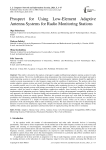
Prospect for Using Low-Element Adaptive Antenna Systems for Radio Monitoring Stations
Статья научная
This article is devoted to the analysis of prospect to apply multifunctional adaptive antenna systems for radio monitoring stations. The review of publications done demonstrates that current antennas that are developed and used in radio monitoring systems to control and measure the parameters of electromagnetic radiation should be applicable to conduct accurate measurements in wide frequency range under the condition of interferences. The analysis shows that modern adaptive antenna systems are mostly developed for radar and telecommunications applications. In this context we consider possible ways to solve the problem of adapting radio monitoring devices to a complex electromagnetic environment using antenna systems with primary processing of received signals . It was found that the developers of the antennas, which are based on adaptive interference suppression methods, focus basically on the development and implementation of adaptation processes, limiting themselves only to solving electromagnetic compatibility problems. In such approach, the functions of direction finding and measurement of radiation field parameters important exactly for radio monitoring systems are mostly ignored. Therefore, this research area opens up a wide field for identifying new possibilities for constructing multifunctional antenna systems. Focusing on this direction of research, we consider as an example the constraction of a simple two-element adaptive antenna system, which can be used to measure the parameters of the electromagnetic field in radio monitoring systems. The main relations for the error of determining the direction of arrival of the interference signal with a simple two-element antenna are investigated. The influence of the stability of the antenna array parameters and functional units of signal processing onto the errors is estimated
Бесплатно
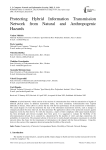
Protecting Hybrid Information Transmission Network from Natural and Anthropogenic Hazards
Статья научная
A hybrid network, which consists of the sections of communication lines with the transmission of signals of different physical nature on different transmission media, has been considered. Communication lines respond differently to threats, which allows to choose the line with the best performance for the transmission of information. The causal diagram of events that determine the state of the information transmission network, such as changes in emergency/accident-free time intervals, has been presented. The application scheme of the protection measures against dangerous events has been shown. To verify the measures, a matrix of their compliance with typical natural disasters has been developed and relevant examples have been given. It is suggested to evaluate the flexibility of the telecommunication network by its connectivity, characterized by the numbers of vertex and edge connectivity, the probability of connectivity. The presented scheme of the device for multi-channel information transmission in a hybrid network allows the choice for the transmission of information to the channel with the best performance. Using this device is the essence of the suggestion about increasing the flexibility of the network.
Бесплатно
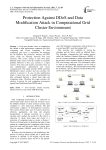
Protection Against DDoS and Data Modification Attack in Computational Grid Cluster Environment
Статья научная
In the past decades, focus of computation has shifted to high performance computing like Grid Computing and Cloud Computing. In Grid computing, grid server is responsible for managing the all resources like processor, memory and CPU cycles. Grids are basically networks that pool resources, CPU cycles, storage or data from many different nodes used to solve the complex or scientific problem. However in this case, security is a major concern. Even most grid security researches focus on user authentication, authorization and secure communication. This paper presents DDoS and Data Modification attack scenario and also provides the solution to prevent it. In case of data modification attack, it shows how easy to read/forward/modify the data exchanged between a cluster head node and computing nodes. Therefore this paper provides the solution to protect the grid computing environment against Data Modification and DDOS attack.
Бесплатно
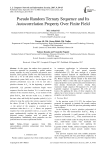
Pseudo Random Ternary Sequence and Its Autocorrelation Property Over Finite Field
Статья научная
In this paper, the authors have proposed an innovative approach for generating a pseudo random ternary sequence by using a primitive polynomial, trace function, and Legendre symbol over odd characteristics field. Let p be an odd prime number, FP be an odd characteristic prime field, and m be the degree of the primitive polynomial f(x) Let w be its zero and a primitive element in Fpm* In the beginning, a primitive polynomial f(x) generates maximum length vector sequence, then the trace function Tr(.) is used to map an element of the extension field (Fpm) to an element of the prime field Fp then non-zero scalar A∈Fp is added to the trace value, and finally the Legendre symbol (a/p) is utilized to map the scalars into ternary sequence having the values, {0,1,and -1} By applying the new parameter A the period of the sequence is extended to its maximum value that is n=pm-1 Hence, our proposed sequence has some parameters such as p,m,and A This paper mathematically explains the properties of the proposed ternary sequence such as period and autocorrelation. Additionally, these properties are also justified based on some experimental results.
Бесплатно
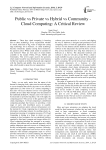
Public vs Private vs Hybrid vs Community - Cloud Computing: A Critical Review
Статья научная
These days cloud computing is booming like no other technology. Every organization whether it's small, mid-sized or big, wants to adapt this cutting edge technology for its business. As cloud technology becomes immensely popular among these businesses, the question arises: Which cloud model to consider for your business? There are four types of cloud models available in the market: Public, Private, Hybrid and Community. This review paper answers the question, which model would be most beneficial for your business. All the four models are defined, discussed and compared with the benefits and pitfalls, thus giving you a clear idea, which model to adopt for your organization.
Бесплатно
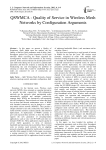
QSWMCA - Quality of Service in Wireless Mesh Networks by Configuration Arguments
Статья научная
In this paper, we present a Quality of Experience (QoE) based upon the analyze the key Quality of Service (QoS) parameters such as delay, jitter, throughput, packet loss, packet inspection in the mesh networks which executing the better approach for reconfiguration wireless mesh networks in the routing protocol. In this system evaluates the actual QoE level for each mesh node taking into an account to calculate QoS parameters and then this response as reducing the node broadcasting rate and investigating the problems of selecting in which links would be established that all nodes are connected for cost of constructions are minimized.
Бесплатно
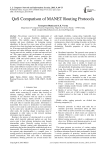
QoS Comparison of MANET Routing Protocols
Статья научная
The primary concern for the deployment of MANET is to promote flexibility, mobility and portability. This mobility causes dynamic change in topology and poses challenges for designing routing algorithms. In the past few years, many ad hoc network protocols have been developed and research is still going on. It becomes quite difficult to say which protocols may perform well under different network scenarios such as varying network size, mobility of nodes and network load etc. This paper analyzes the performance of proactive protocols like DSDV, OSLR, reactive protocols like AODV, DSR and hybrid protocol such as ZRP. The analysis guides us to the evaluation of various performance metrics such as throughput, packet delivery fraction, normalized routing load and average end to end delay under different scenarios such as varying network size, speed of the node and pause time. The focus of this paper is to have quantitative analysis to guide which protocol to choose for specified network and goal.
Бесплатно
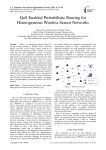
QoS Enabled Probabilistic Routing for Heterogeneous Wireless Sensor Networks
Статья научная
There is an increasing research interest in solving routing problems in Wireless Sensor Networks (WSN) and most of the existing routing protocols for WSN consider homogeneous nodes wherein, all sensor nodes have the same capabilities in terms of sensing, communication and computation capabilities. However, deployment of a homogeneous sensor network may suffer from poor performance. In this paper, we present a novel QoS routing scheme that adaptively learns an optimal routing strategy, depending on multiple optimization goals. We base our approach on Ant Colony Optimization (ACO) technique which is insensitive to initial setting, thus ideal in the context of WHSNs. The key feature of the protocol is its ability to meet diverse QoS requirements posed by different kinds of traffic generated due to heterogeneous nature of nodes thus maximizing network performance and utilization. Experimental results suggest a significant gain in the performance of proposed protocol over AODV protocol.
Бесплатно
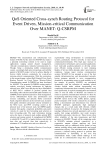
Статья научная
The decentralized and infrastructure less feature of Mobile Ad-hoc network (MANET) has made it a potential networking solution to be used in major applications ranging natural disaster management, vehicular communication, industrial communication etc. Though, being a dominating mobile communication system, exceedingly high network topology and mobility pattern in MANETs make it trivial to achieve Quality of Service (QoS) delivery, particularly for event-driven (mission-critical) communication. With this motivation, in this research paper a robust QoS Oriented Cross-Synch Routing Protocol for Event Driven, Mission-Critical Communication named Q-CSRPM has been developed for MANET. The proposed Q-CSRPM routing protocol exploits cross-layer routing architecture by applying network layer, MAC layer and physical layer information of IEEE 802.11 standard to perform optimal best forwarding node selection and reliable path formation. Q-CSRPM protocol performed proactive node management, service differentiation based data prioritization and resource scheduling, and dynamic buffer assessment based congestion detection at the network layer, dynamic link quality estimation and packet velocity estimation at the MAC layer, and PHY switching control at the physical layer of the protocol stack. Q-CSRPM applies dynamic link quality, congestion probability and packet velocity of a node for best forwarding node selection to form forwarding path. The node information sharing across the layers of rotocol stack enables optimal BFN selection and routing control. It strengthened Q-CSRPM to exhibit 98.2% and 93% of packet delivery ratio for real time data and non-real time data respectively. A minimum of 2% deadline miss ratio was observed.
Бесплатно
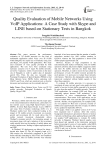
Статья научная
This paper presents the performance evaluation of 3G mobile networks for one kind of multimedia application called Voice over IP (VoIP) within Bangkok, the capital city of Thailand, using Line and Skype, two popular VoIP applications. This study used evaluation of voice quality provided by both applications. The tests have been conducted using stationary scenarios over 5 major 3G mobile networks, served by 5 operators, within 14 universities in the inner city of Bangkok in order to gather data of degraded speech files. Then, the data was measured using Perceptual Evaluation of Speech Quality (PESQ) to find Mean Opinion Score (MOS) before analyzing with ANOVA and T-test, which are statistical tools, so that the discussion and conclusion can be eventually derived.
Бесплатно

Статья научная
Multi-access Edge Computing optimizes computation in proximity to smart mobile devices, addressing the limitations of devices with insufficient capabilities. In scenarios featuring multiple compute-intensive and delay-sensitive applications, computation offloading becomes essential. The objective of this research is to enhance user experience, minimize service time, and balance workloads while optimizing computation offloading and resource utilization. In this study, we introduce dynamic computation offloading algorithms that concurrently minimize service time and maximize the quality of experience. These algorithms take into account task and resource characteristics to determine the optimal execution location based on evaluated metrics. To assess the positive impact of the proposed algorithms, we employed the Edgecloudsim simulator, offering a realistic assessment of a Multi-access Edge Computing system. Simulation results showcase the superiority of our dynamic computation offloading algorithm compared to alternatives, achieving enhanced quality of experience and minimal service time. The findings underscore the effectiveness of the proposed algorithm and its potential to enhance mobile application performance. The comprehensive evaluation provides insights into the robustness and practical applicability of the proposed approach, positioning it as a valuable solution in the context of MEC networks. This research contributes to the ongoing efforts in advancing computation offloading strategies for improved performance in edge computing environments.
Бесплатно
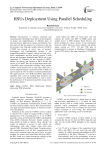
RSUs Deployment Using Parallel Scheduling
Статья научная
Advancement in software, hardware and communication technologies have led to the development of design and implementation of different types of networks that are deployed in various environments. One such network that has gained a lot of interest in the last few decades is the Vehicular Ad-Hoc Network (VANET). VANET has become an active area of research, development and standardization because it has remarkable potential to improve vehicle and road safety, traffic management, and also provide comfort to both drivers and passengers. Roadside units (RSUs) are a vital component of Vehicular ad hoc network (VANET). Mainly, the density and location of RSUs decides the success of a VANET. But, the sky-high deployment costs of the RSUs make it impossible to deploy a large number of RSUs on the specific area or road. Thus, there rises a need to optimally deploy a restricted number of RSUs in a given region in order to achieve maximum performance. This paper presents a new TDB based RSUs deployment algorithm with a goal of attaining high efficiency and cover maximum area. Matlab platform is used to assess the performance of the proposed algorithm using several performance metrics.
Бесплатно
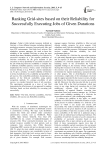
Ranking Grid-sites based on their Reliability for Successfully Executing Jobs of Given Durations
Статья научная
Today's Grids include resources (referred as Grid-site s) from different domains including dedicated production resources, resources from university labs, and even P2P en¬vironments. Grid high level services, like schedulers, resource managers, etc. need to know the reliability of the available Grid-sites to select the most suitable from them. Modeling reliability of a Grid-site for successful execution of a job requires prediction of Grid-site availability for the given duration of job execution as well as possibility of successful execution of the job. Predicting Grid-site availability is complex due to different availability patterns, resource sharing policies implemented by resource owners, nature of domain the resource belongs to (e.g. P2P etc.), and its maintenance etc. To give a solution, we model reliability of Grid-site in terms of prediction of its availability and possibility of job success. Our availability predictions incorporate past patterns of the Grid-site availability using pattern recognition methods. To estimate possibility of job success, we consider historical traces of job execution. The experiments conducted on a trace of real Grid demonstrate the effectiveness of our approach for ranking Grid-sites based on their reliability for executing jobs successfully.
Бесплатно
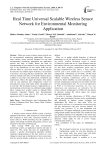
Real time universal scalable wireless sensor network for environmental monitoring application
Статья научная
There are several wireless sensor network use for environmental monitoring applications. However, most wireless sensor network designed for real time environmental monitoring application are application specific and static in nature. Hence, the need for reprogramming of base station for every change in sensor type or the introduction of new sensor node into the network. More so, since these sensors nodes are deploy by end users in a random region of interest, it is necessary to develop a new plug and play mechanisms with more software modules and more user-friendly interface that is scalable to ease larger area deployment, installation and maintenance. Hence, this paper developed a base station with an auto detection and configuration system for detecting new sensor node, faulty nodes, and update user in real time. The developed system is implemented on a mesh topology network and was calibrated using standard Davis vantage pro2 weather station in Ahmadu Bello University Liquefied Natural Gas Environmental Laboratory and a mean error of 0.12 and root mean square error of 0.14 were obtained.
Бесплатно
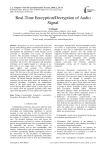
Real-Time Encryption/Decryption of Audio Signal
Статья научная
Encryption is a way to secure and verify data that are traded through public communication channels in the presence of intruder party called antagonists. Consequently, the transmitted or stored message can be converted to unreadable form except for intended receivers. The decryption techniques allows intended receiver to reveal the contents of previously encrypted message via secrete keys exchanged exclusively between transmitter and receiver. The encryption and decryption techniques can be applied equally to a message in any form such as text, image, audio or video. The current paper applies and evaluate two different encryption/decryption algorithms to the real-time audio signal. The first one is the well-known RSA encryption and decryption technique, while the second one is a new suggested algorithm based on symmetric cryptography concept. The Matlab Simulink simulator tool is used for acquiring the real-time audio signal and simulating the proposed algorithms. Considering the mathematical nature of the audio signal, the experimental results showed that the RSA method yields an audio signal with low quality while the suggested algorithm yields audio signal with high quality as exact signal as the original one.
Бесплатно
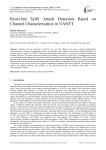
Real-time Sybil Attack Detection Based on Channel Characterization in VANET
Статья научная
Vehicular Ad hoc Networks (VANETs) are vital for efficient and secure vehicle-to-infrastructure communication in intelligent transportation systems. sybil attacks, where malicious entities adopt multiple identities, are a major security concern in VANETs. Detecting and mitigating these attacks is crucial for ensuring communication reliability and trust. This article focuses on detecting sybil attacks in Vehicle-to-Vehicle (V2V) communication by using a novel mechanism that characterizes the wireless channel through Received Signal Strength Indicator (RSSI) and angular spread in both azimuth and elevation planes. By incorporating angular spread alongside RSSI, the proposed mechanism offers more accurate and robust detection, particularly in dense vehicle environments. Utilizing a precise wireless channel model based on ray tracing statistics, the approach outperforms traditional RSSI-based methods. Experimental results confirm the enhanced accuracy and reliability of the proposed mechanism for detecting sybil attacks in V2V communication scenarios.
Бесплатно
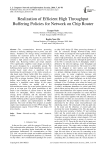
Realization of Efficient High Throughput Buffering Policies for Network on Chip Router
Статья научная
The communication between processing elements is suffering challenges due to power, area and latency. Temporary flit storage during communication consumes the maximum power of the whole power consumption of the chip. The majority of current NoCs consume a high amount of power and area for router buffers only. Removing buffers and virtual channels (VCs) significantly simplifies router design and reduces the power dissipation by a considerable amount. The buffering scheme used in virtual channeling in a network-on-chip based router plays a significant role in determining the performance of the whole network-on-chip based mesh. Elastic buffer (EB) flow control is a simple control logic in the channels to use pipeline flip-flops (FFs) as storage locations. With the use of elastic buffers, input buffers are no longer required hence leading to a simplified router design. In this paper properties of buffers are studied with a test microarchitecture router for several packet injection rates given at an input port. The prime contribution of this article is the evaluation of various forms of the elastic buffers for throughput, FPGA resource utilization, average power consumed, and the maximum speed offered. The article also gives a comparison with some available buffering policies against throughput. The paper presents the synthesis and implementation on FPGA platforms. The work will help NoC designers in suitable simple router implementation for their FPGA design. The implementation targets Virtex5 FPGA and Stratix III device family.
Бесплатно
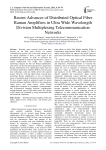
Статья научная
Recently, many research works have been focused on the fiber optic devices for optical communication systems. One of the main interests is on the optical amplifiers to boost a weak signal in the communication systems. In order to overcome the limitations imposed by electrical regeneration, a means of optical amplification was sought. The competing technology emerged: the first was Raman amplification. One reason was that the optical pump powers required for Raman amplification were significantly higher than that for Erbium doped fiber amplifier (EDFA), and the pump laser technology could not reliably deliver the required powers. However, with the improvement of pump laser technology Raman amplification is now an important means of expanding span transmission reach and capacity. We have deeply studied an analytical model for optical distributed Raman amplifiers (DRAs) in the transmission signal power and pump power within Raman amplification technique in co-pumped, counter-pumped, and bi-directional pumping direction configurations through different types of fiber cable media. The validity of this model was confirmed by using experimental data and numerical simulations.
Бесплатно
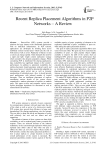
Recent Replica Placement Algorithms in P2P Networks – A Review
Статья научная
Peer-to-Peer (P2P) systems provide a platform for large internet scale distributed applications with no dedicated infrastructure. In P2P systems, applications are developed by dividing them across individual systems termed peers which take the role of both client as well as server. Popularity of objects in such a system can change rapidly, which demands the need for a rapid and light weight content replication strategy which considers this dynamic popularity changes. While considering P2P in distributed file sharing applications, data availability has significant impact on the system's performance. In addition to optimized availability, the replica placement should guarantee reduced search and data access latency. It should be dynamically adaptable to instantaneous query arrival rate as well as dynamic membership of individual peers. Also, it should provide good performance with reduced number of control messages. Thus an intelligent placement of replicas considering various factors of the system always outperforms a random placement of replicas on random peers. This paper reviews and compares various recent replica placement algorithms for structured as well as unstructured P2P networks.
Бесплатно

Reciprocity based Energy Efficient Cooperative Routing Protocol for WSNs
Статья научная
Prolonging network lifetime by salvaging the energy of low battery capacity nodes is a prime concern in Wireless Sensor Networks. Energy efficient routing protocols try to improve the node lifetime by restricting their participation in the routing process. This leads to selfish node behavior causing disruption of inherent network cooperation. This paper proposes an elegant routing mechanism based on direct reciprocity principle, named energy efficient cooperative ad hoc on-demand distance vector (EECoAODV). Proposed protocol correctly differentiates between inherently selfish nodes that use the energy of other nodes to relay their packets, but refuse to reciprocate; and the energy critical nodes that have turned non-cooperative for their own survival. Selfish nodes are punished and eliminated from the routing process thus prolonging the battery capacity of energy critical nodes to improve the overall network performance. EECoAODV is implemented in Qualnet simulator and its performance is compared with conventional AODV and reinforcement based state-action-reward-action (SARSA) routing mechanism. Results show that EECoAODV improves the lifetime of energy critical nodes and thus delivers improved packet delivery ratio than SARSA-AODV and conventional AODV.
Бесплатно

